Leucospermum cuneiforme
| Botanical Name | Leucospermum cuneiforme |
|||||||||||
| Family | Proteaceae - The Protea family
|
|||||||||||
| Pronunciation | loo-koh-SPER-mum kew-nee-FORM-uh |
|||||||||||
| Common Name(s) |
English: Common Pincushion; Wart-stemmed Pincushion
Afrikaans: Gewone Luisiesbos; Luisiesbos
IsiXhosa: Isiqwane
|
|||||||||||
| Plant Group |
|
|||||||||||
| Plant Size |
|
|||||||||||
| Position |
|
|||||||||||
| General Information |
|
|||||||||||
| Specific Information | Leucospermum cuneiforme occurs in a wide range of habitats, vegetation types and climates in both winter and summer rainfall areas. It forms a stout medium sized shrub, although it has been known to reach up to 3m. A distinguishing and unique characteristic is that the branches at the base of the plant are covered with warts. The green leathery leaves are wedge-shaped with 3 to 10 teeth along the top edge of the leaf. The flower heads are oval and the colour varies, depending on the region in which it grows. The flowers themselves also change colour as they develop, starting with yellow and ageing to various shades of light orange. Leucospermum cuneiforme is extremely fire resistant, resprouting from the underground rootstock after a fire. In the wild the seeds are distributed by ants which carry the seeds to their nests and eat the fleshy outer coating without damaging the seed itself. The safely stored and buried seeds germinate after a fire. Because of its wide habitat range, Leucospermum cuneiforme adapts easily to garden culture and is an excellent choice for gardens both in and out of its natural areas. |
|||||||||||
| Ad Break | ||||||||||||
| Flowers | ||||||||||||
| Description | made up of many small flowers clustered on an oval-shaped head 50 - 90 mm wide, at the ends of branches |
|||||||||||
| Season |
|
|||||||||||
| Colour |
|
|||||||||||
| Growth Rate |
|
|||||||||||
| Plant Uses |
|
|||||||||||
| Distribution and Habitat | from the Caledon district in the Western Cape to north of East London in the Eastern Cape, in fynbos, arid fynbos, on the fringes of the Little Karoo, in grassveld, subtropical coastal dune forest and in the margins of evergreen forests |
|||||||||||
| Planting Suggestions | Leucospermum cuneiforme needs a sunny position in well-drained sandy, acidic soil (although mine are growing in neutral to slightly alkaline soil), where there is free circulation of air. Prune regularly to shape. As with most members of the Protea Family, Leucospermum cuneiforme is adapted to nutrient poor soils and has fine and sensitive roots that cannot cope with strong fertilisers or manure. Use organic, slow release fertilisers and mulch regularly with well-rotted compost, milled bark or pine needles. Leucospermum cuneiforme will tolerate summer drought, but will respond better if given a deep weekly or bi-weekly watering throughout the year. Do not dig or weed for a meter or more around the shrub or the roots will be disturbed and may become diseased - rather control weeds with a deep layer of mulch. The specimen in the photos does not pay justice to this pincushion as it is completely water wise, has survived many years of drought and has not been pruned in 30 years, hence its rather sparse appearance. |
|||||||||||
| Medicinal Uses | No data found. |
|||||||||||
| Ad Break | ||||||||||||


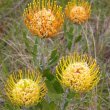
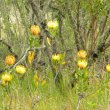
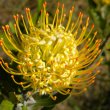
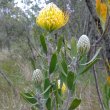
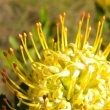
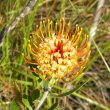


Comments
Pruning/cutting back
A big advantage of this plant is that it can be drastically pruned/cut back below "leaf level"!
Of course with most members of the protea family cutting a stem below leaf level causes the stem to die!
Discuss this plant
Share knowledge, ask a question or give an experience.